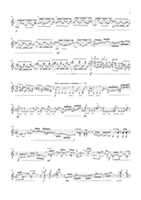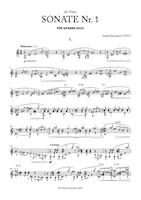Die sechs Ansichten des Kirchturms zu Springiersbach
(The six views of the steeple in Springiersbach)
| finished | 16th May 2003 |
| dedication | – |
| movements | Prolog – 1. Moderato – 2. Vivo – 3. Poco pesante – 4. Allegretto – 5. Andante con moto e serioso – 6. Fluente – Epilog |
| duration | approx. 8 min. |
| first performance | 21st October 2003 in the Curt-Sachs-Hall of the Music Instrument Museum in Berlin |
| published at | Joachim-Trekel-Musikverlag |
The idea to this piece originated in 1999 during an orchestral trip to Springiersbach. I found the steeple of the village so fascinating, that I kept finding new perspectives to take photos of it and finally decided to make a variation cycle.
I composed six views in a romantic/impressionistic musical language which are very suited to be played on the guitar. Designed as bell-ringing, a prologue and an epilogue are the frame movements of the piece.
“Die sechs Ansichten des Kirchturms zu Springiersbach” won a 2nd prize of the contest “Jugend komponiert” (Youth composes) in 2003.
Fünf Stücke
(Five pieces)

| finished | 5 December 2003 |
| dedication | Michael Kubik |
| movements | 1. »Gestern« (Yesterday) – 2. »Sieben« (Seven) – 3. »Eis« (Ice) – 4. »Mosaik« (Mosaic) – 5. »Dunkel« (Dark) |
| duration | 2:45 min – 1:10 min. – 2:30 min. – 2:45 min. – 2:10 min. |
| first performance | – |
| published at | – |
The harmony of the Five pieces bases on three elements: 1. free till strict dodecaphony 2. chords of quints and quarts altered parallelly 3. heavy chromaticalization
The first piece describes the process of remembering. Single elements form little by little more complex thoughts that, once remembered, immediately disappear to leave space for other elements.
The second piece can be traced back completely to the number 7. It uses the 7/8 beat and consists of seven parts each of which is seven measures long. Thereby the level of suspension is exactly opposite to usual ones.
In the third piece state is the focus, not movement. An ice surface is more and more set under tension, so that it breaks at the end. All notes of the trills and tremolos in this movement are organized via dodecaphony.
Similar to the first piece the fourth one assembles little bricks (mosaic stones) to a bigger structure. There is a big climax here, too, before the middle section starts in a totally different style as a little sonata movement. The return of the main part reminds some of the structures from the beginning, before a meander-like band ends the movement with chromatically moving arpeggios.
The title of the last piece determines its timbre and registration. It is a free form, the most prominent attribute of which is the changes between moved and static moments.
Guitar sonata in D major
| finished | August 1995 |
| dedication | – |
| movements | 1. Allegro – 2. Andante – 3. Rondo: Allegro vivace |
| duration | approx. 18 min. |
| first performance | – |
| published at | – |
Like classical models the sonata consists of three movements. The first movement in sonata form shows two quite contrasting themes in 2/4 and 3/4 beat and a more episodic than evolving development.
The andante is a variation movement in G major.
The third movement, a rondo, is mostly dominated by virtuous motion in semiquavers. A cadenza-like insertion with a following andante mysterioso prepares the last appearance of the rondo theme. After a big accelerando the sonata ends surprisingly in piano.
Lamento
| finished | December 2009 |
| dedication | Eva Frommbach (posthumously) |
| movements | – |
| duration | approx. 6:40 min. |
| first performance | – |
| published at | PDF available, e-mail me |
“Lamento” is a very personal composition, written as a requiem on a good friend of mine, who died of a severe desease in November 2009.
Passagen

| finished | 19 February 2013 |
| dedication | Judith Beschow |
| movements | – |
| duration | 8 min. |
| first performance | – |
| published at | – |
The concert fantasia “Passagen” was written in 2013 at the suggestion of Judith Beschow for her guitar exam.
The work is a parable about on chorale “Jesu, Joy of Man’s Desiring” from cantata BWV 147 by Johann Sebastian Bach. The actual subject is the instrumental introduction of the choir which the music arises from and returns to.
In between various characteristics develop: after a prelude-like beginning with different arpeggio shapes a milonga section follows presenting new material. A significant break with accelerando leads to a grotesque haunting full of original effects and wild rhythms, exposing the monogram B-A-C-H (b, a, c, b-flat) and then presenting the main theme as if it was appearing as in a distorting mirror.
After it has dissolved into fluorescent crumbs, the action calms down and what follows is the work’s emotional center of outmost calm – a shimmering variation of the actual chorus melody, which was not even heard until then. The dramatic climax builds up afterwards, when the main subject is presented with romantic figurations first minor, then in glorious D major. Arpeggios, runs and full chords produce a magnificent sound.
The music calms down again, through the back door approaches the theme from the beginning. The circle is complete, and the end of the work is now slower than the beginning and sounds very solemn and noble, sparingly applied with bass tones entirely by the pen of J. S. Bach.
Prélude No. 1

| finished | 16 April 2019 |
| dedication | Timon Jahn |
| movements | – |
| duration | 5 min. |
| first performance | – |
| published at | – |
The “Prélude No. 1” was written at the suggestion of Timon Jahn who is also the dedicatee of the work. It is a concert piece in the tradition of the Prelúdios by H. Villa-Lobos. The musical language ranges from free-tonal romanticism to chromatic structures based on the tuning of the guitar’s strings.
Calm arpeggios decorated with trills begin the piece in A minor. An expressive melody in B major follows, with mild dissonances like sixths and sevenths flavouring the accompanying chords. Triplets animate the music, which is now back in the tonality around A minor.
After a caesura the contrasting middle section starts: a Vivace scherzoso in 4/8. Beginning with a single voice, it uses mostly figures based on similar or equal fingerings on different strings. The mood is mysterious to bizarre, and occasionally somewhat harsh. Suddenly the music runs into nothingness, parallel chords raise the tension, then shimmering chords over a pedal tone… A ritardando finally leads the section back to the reoccurrence of the main part.
The coda follows the expressive B major episode. Contentwise it recaps the triplet section from earlier, but now with vivid sixteenth notes in bright A major. Then rousing arpeggios lead to the guitar’s high registers and finish the piece in radiant fortissimo with a brilliant final chord.
The difficulty of the “Prélude No. 1” is aimed to be in the upper-intermediate level. I attempted to write rewarding music, i. e. to provide a maximum an musical substance and beauty for the technical efforts demanded.
SONATE Nr. 1

| finished | 18 August 2024 |
| dedication | Timon Jahn |
| movements | 1. Maestoso – 2. Scherzo. Vivace – 3. Andante cantabile – 4. Lento sostenuto, Allegro con brio |
| duration | 23 min. |
| first performance | – |
I had wanted to write guitar sonata for many years. When Timon Jahn told me that he was planning to play only my works in his bachelor concert and asked me for a large scale sonata, I was delighted to have the honour and the opportunity to finally compose the piece I had been planning for such a long time. The result is a serious work in four movements, which is not inferior in scope and content to great sonatas of the classical-romantic era.
The first movement is an expansive, dramatic sonata movement lasting almost ten minutes. Two important ideas are introduced right at the beginning: an ascending motif consisting of a minor second and a fifth, and the harmonic element of the mediantic relation. The main theme begins Maestoso in a mysterious mood. This is followed by the secondary theme Con moto, which contrasts strongly with its dotted notes and the accompaniment in semiquavers. The development section brings dramatic intensifications and leads to a magnificent recapitulation that makes use of all the guitar’s registers. The movement ends in a calm mood with a bright E major chord.
This is followed by a hasty scherzo in 2/4 time, which is almost monothematic in conception. The musical material is transformed in a variety of ways and develops into several dramatic climaxes. There is no trio—after a few minutes, the spook is over.
In the slow movement, an Andante cantabile in 3/4 time, a romantic cantilena unfolds, characterized by chromaticism and repeated notes. In the development, a fugato section leads the theme into a passionate climax. The movement ends transfigured and extremely calmly in the high registers of the guitar.
Latin American rhythms dominate the final movement. A short introduction is followed by an extremely spirited and fiery five-part rondo. The movement closes the circle by referring to ideas from the first movement in the second couplet. The sonata ends in E major with a very powerful and brilliant coda, which brings both the movement and the whole work to an impressive conclusion.
Toskanische Skizzen

| finished | 3 March 2014 |
| dedication | Christoph Belz and his pupils |
| movements | – |
| duration | approx. 8:30 min. |
| first performance | – |
| published at | PDF available, e-mail me |
The idea for the “Toskanische Skizzen” (Tuscan sketches) originates from a trip to Montepulciano, Italy in 2009. The result are four miniatures, depicting strong impressions of the stay in small scenes.
Montepulciano’s influential Ricci family built the Palazzo Ricci in the 16th century. The first sketch tells the eventful history of this palace. After the first flowering period followed a time of decay and oblivion, until in modern times the restoration of the building complex took place. Today the Palazzo has a new look and functions as a European Academy of Music.
Pienza is a small town in Tuscany, some 15 km from Montepulciano. The second sketch portrays the picturesque gem, whose historic center was declared in 1996 by the UNESCO as a World Heritage Site. A steady rain comes down on dilapidated buildings and narrow streets, but after a short thunderstorm the clouds vanish and the first rays of sun bath the city in a friendly light again.
Not far from the Palazzo Ricci the Piazza Grande is the center of Montepulciano. The short third sketch describes the oppressive heat on the deserted place in the early afternoon. Church bells ring, and suddenly the place is crowded by a group of travelers, talking loudly and laughing. They disappear into an alley as quickly as they came, and leave the Piazza Grande in silence.
The fourth sketch is by far the longest and dedicated to the evening in Montepulciano. The heat of the day is over, the dawn breaks in and all around the city shines in soft lantern light. It is the time to sit down with friends to the curb over a glass of Vino Nobile with the day’s reminisce in one’s mind and a magical atmosphere to enjoy.
